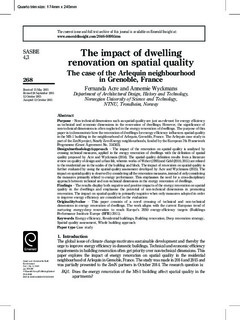| dc.contributor.author | Acre, Fernanda | |
| dc.contributor.author | Wyckmans, Annemie | |
| dc.date.accessioned | 2017-10-02T14:10:40Z | |
| dc.date.available | 2017-10-02T14:10:40Z | |
| dc.date.created | 2015-04-23T15:12:23Z | |
| dc.date.issued | 2015 | |
| dc.identifier.citation | Smart and Sustainable Built Environment. 2015, 4 (3), 268-309. | nb_NO |
| dc.identifier.issn | 2046-6099 | |
| dc.identifier.uri | http://hdl.handle.net/11250/2457836 | |
| dc.description.abstract | Purpose – Non-technical dimensions such as spatial quality are just as relevant for energy efficiency as technical and economic dimensions in the renovation of dwellings. However, the significance of non-technical dimensions is often neglected in the energy renovation of dwellings. The purpose of this paper is to demonstrate how the renovation of dwellings for energy efficiency influences spatial quality in the MS-1 building in the neighbourhood of Arlequin, Grenoble, France. The Arlequin case study is part of the ZenN project, nearly zero energy neighbourhoods, funded by the European 7th Framework Programme (Grant Agreement No. 314363).
Design/methodology/approach – The impact of the renovation on spatial quality is analysed by crossing technical measures, applied in the energy renovation of dwellings with the definition of spatial quality proposed by Acre and Wyckmans (2014). The spatial quality definition results from a literature review on quality of design and urban life, wherein works of Weber (1995) and Gehl (2010, 2011) are related to the residential use in the scales of the building and block. The impact of renovation on spatial quality is further evaluated by using the spatial quality assessment developed by Acre and Wyckmans (2015). The impact on spatial quality is observed by considering all the renovation measures, instead of only considering the measures primarily related to energy performance. This emphasises the need for a cross-disciplinary approach between technical and non-technical dimensions in the energy renovation of dwellings.
Findings – The results display both negative and positive impacts of the energy renovation on spatial quality in the dwellings and emphasise the potential of non-technical dimensions in promoting renovation. The impact on spatial quality is primarily negative when only measures adopted in order to improve energy efficiency are considered in the evaluation.
Originality/value – This paper consists of a novel crossing of technical and non-technical dimensions in energy renovation of dwellings. The work aligns with the current European trend of nurturing energy-deep renovation to reach Europe’s 2050 energy-efficiency targets (Buildings Performance Institute Europe (BPIE) 2011). | nb_NO |
| dc.language.iso | eng | nb_NO |
| dc.publisher | Emerald | nb_NO |
| dc.title | The Impact of Dwelling Renovation on Spatial Quality - The Case of the Arlequin Neighbourhood in Grenoble, France | nb_NO |
| dc.type | Journal article | nb_NO |
| dc.type | Peer reviewed | nb_NO |
| dc.source.pagenumber | 268-309 | nb_NO |
| dc.source.volume | 4 | nb_NO |
| dc.source.journal | Smart and Sustainable Built Environment | nb_NO |
| dc.source.issue | 3 | nb_NO |
| dc.identifier.doi | 10.1108/SASBE-05-2015-0008 | |
| dc.identifier.cristin | 1238779 | |
| dc.description.localcode | © Emerald 2015. This is the authors’ accepted and refereed manuscript to the article. | nb_NO |
| cristin.unitcode | 194,61,25,0 | |
| cristin.unitname | Institutt for byggekunst, historie og teknologi | |
| cristin.ispublished | true | |
| cristin.fulltext | postprint | |
| cristin.qualitycode | 1 | |
